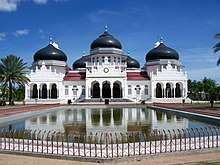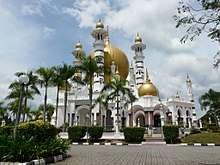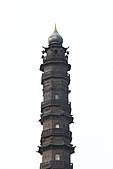Onion dome
An onion dome (Russian: луковичная глава, lúkovichnaya glavá; compare Russian: лук, luk, "onion") is a dome whose shape resembles an onion and is usually associated with Russian architectural style.[1] Such domes are often larger in diameter than the tholobate upon which they sit, and their height usually exceeds their width. These bulbous structures taper smoothly to a point.
It is a typical feature of churches belonging to Russian Orthodox church. Occasionally, there are similar buildings in European countries like in Germany in Bavaria, (German: Zwiebelturm (literally "onion tower") in Austria, the Czech Republic, northeastern Italy, in other Eastern European countries and in Oriental regions like Mughal India, the Middle East and Central Asia. However, the old buildings outside of Russia usually do not have the distinctive typical construction of the Russian onion design. Probably the origin lies in the native architectural style of early Rus' tribes.
Other types of Eastern Orthodox cupolas include helmet domes (for example, those of the Assumption Cathedral in Vladimir), Ukrainian pear domes (Saint Sophia Cathedral in Kiev), and Baroque bud domes (St. Andrew's Church in Kiev) or an onion-helmet mixture like the Saint Sophia Cathedral in Novgorod.
History
_%D0%B2_%D0%9A%D0%BE%D1%81%D1%82%D1%80%D0%BE%D0%BC%D0%B5.jpg)
It is not completely clear when and why onion domes became a typical feature of Russian architecture. The curved onion style appeared outside of Russia, both in the Western world and in the Orient at a later time.[2] But still several theories exist that the Russian onion shape was influenced by countries from the Orient, like India and Persia, with whom the Russian population and culture through history has always been in cultural exchange. Byzantine churches and architecture of Kievan Rus were characterized by broader, flatter domes without a special framework erected above the drum. In contrast to this ancient form, each drum of a Russian church is surmounted by a special structure of metal or timber, which is lined with sheet iron or tiles, while the onion architecture is mostly very curved. Russian architecture used the dome shape not only for churches but also for other buildings.
By the end of the nineteenth century, most Russian churches from before the Petrine period had bulbous domes. The largest onion domes were erected in the seventeenth century in the area around Yaroslavl, incidentally famous for its large onions. Quite a few had more complicated bud-shaped domes, whose form derived from Baroque models of the late seventeenth century. Pear-shaped domes are usually associated with Ukrainian Baroque, while cone-shaped domes are typical for Orthodox churches of Transcaucasia.
Traditional view
_temple_(2312558744).jpg)
Supposedly, Russian icons painted before the Mongol invasion of Rus' of 1237-1242 do not feature churches with onion domes. Two highly venerated pre-Mongol churches that have been rebuilt—the Assumption Cathedral and the Cathedral of Saint Demetrius, both in Vladimir—display golden helmet domes. Restoration work on several other ancient churches has revealed some fragments of former helmet-like domes below newer onion cupolas. It has been posited that onion domes first appeared in Russia during the reign of Ivan the Terrible (r. 1533–1584). The domes of Saint Basil's Cathedral have not been altered since the reign of Ivan's son Fyodor I (r. 1584–1598), indicating the presence of onion domes in the sixteenth-century Russia.
Some scholars postulate that the Russians borrowed onion domes from Muslim countries, possibly from the Khanate of Kazan, whose conquest in 1552 Ivan the Terrible commemorated by erecting St. Basil's Cathedral.[3] Eight of the nine domes featured on St. Basil's Cathedral represent each attack on Kazan. The ninth dome was constructed 36 years after the siege of Kazan as a tomb for Ivan. The ornate finishes of these domes are bright in color and bold in shape as they are adorned with pyramids and stripes, and many other patterns seen on other cathedrals than Basil's.[4] Some scholars believe that onion domes first appeared in Russian wooden architecture above tent-like churches. According to this theory, onion domes were strictly utilitarian, as they prevented snow from piling on the roof.[5]
Modern view
In 1946, the historian Boris Rybakov, while analysing miniatures of ancient Russian chronicles, pointed out that most of them, from the thirteenth century onward, display churches with onion domes rather than helmet domes.[6] Nikolay Voronin, the foremost authority on pre-Mongol Russian architecture, seconded his opinion that onion domes existed in Russia as early as the thirteenth century, although they presumably could not be widespread.[7] These findings demonstrated that Russian onion domes could not be imported from the Orient, where onion domes did not replace spherical domes until the fifteenth century.
Sergey Zagraevsky, a modern art historian, surveyed hundreds of Russian icons and miniatures, from the eleventh century onward. He concluded that most icons painted after the Mongol invasion of Rus display only onion domes. First onion domes displayed on some pictures of twelfth century (two miniatures from Dobrylov Evangelie).[8] He found only one icon from the late fifteenth century displaying a dome resembling the helmet instead of an onion. His findings led him to dismiss fragments of helmet domes discovered by restorators beneath modern onion domes as post-Petrine stylisations intended to reproduce the familiar forms of Byzantine cupolas. Zagraevsky also indicated that the oldest depictions of the two Vladimir cathedrals represent them as having onion domes, prior to their replacement by classicizing helmet domes. He explains the ubiquitous appearance of onion domes in the late thirteenth century by the general emphasis on verticality characteristic of Russian church architecture from the late twelfth to early fifteenth centuries.[9] At that period, porches, pilasters, vaults and drums were arranged to create a vertical thrust, to make the church seem taller than it was.[10] It seems logical that elongated, or onion, domes were part of the same proto-Gothic trend aimed at achieving pyramidal, vertical emphasis.[11]
Symbolism
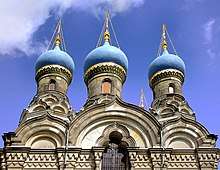
Prior to the eighteenth century, the Russian Orthodox Church did not assign any particular symbolism to the exterior shape of a church.[12] Nevertheless, onion domes are popularly believed to symbolise burning candles. In 1917, noted religious philosopher Prince Yevgeny Trubetskoy argued that the onion shape of Russian church domes may not be explained rationally. According to Trubetskoy, drums crowned by tapering domes were deliberately scored to resemble candles, thus manifesting a certain aesthetic and religious attitude.[13] Another explanation has it that the onion dome was originally regarded as a form reminiscent of the aedicula (cubiculum) in the Church of the Holy Sepulchre in Jerusalem.[14]
Onion domes often appear in groups of three, representing the Holy Trinity, or five, representing Jesus Christ and the Four Evangelists. Domes standing alone represent Jesus. Vasily Tatischev, the first to record such interpretation, disapproved of it emphatically. He believed that the five-domed design of churches was propagated by Patriarch Nikon, who liked to compare the central and highest dome with himself and four lateral domes with four other patriarchs of the Orthodox world. There is no other evidence that Nikon ever held such a view.
The domes are often brightly painted: their colors may informally symbolise different aspects of religion. Green, blue, and gold domes are sometimes held to represent the Holy Trinity, the Holy Spirit, and Jesus, respectively. Black ball-shaped domes were once popular in the snowy north of Russia.
Internationally
Asia
The onion dome is not only found in Russian architecture: it was also used extensively in Mughal architecture, which later went on to influence Indo-Saracenic architecture. Outside India, it is also used in Iran and other places in the Middle East and Central Asia. At the end of the 19th century, the Dutch built Baiturrahman Grand Mosque in Aceh, Indonesia, which incorporated onion shaped dome. The shape of the dome has been used in numerous mosques in Indonesia since then.
Europe
Western & Central countries
Baroque domes in the shape of an onion (or other vegetables or flower-buds) were common in the Holy Roman Empire as well. The first one was built in 1576 by the architect John Holl (1512–1594) on the church of the Convent of the Franciscan Sisters of Maria Stern in Augsburg. Usually made of copper sheet, onion domes appear on Catholic churches all over southern Germany, Czech lands, Austria and Sardinia and Northeast Italy. Onion domes were also a favourite of 20th-century Austrian architectural designer Friedensreich Hundertwasser.
 Saint Leonard's Church in Mittersill (Austria)
Saint Leonard's Church in Mittersill (Austria)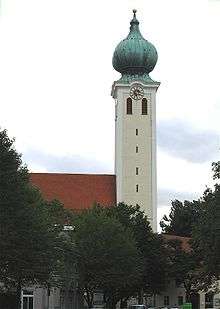

Southern countries
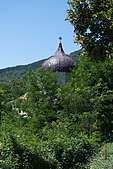 Cupola of St. Athanasius Church in Selci (North Macedonia)
Cupola of St. Athanasius Church in Selci (North Macedonia)
The Americas
The World's Only Corn Palace, a tourist attraction and basketball arena in Mitchell, South Dakota, also features onion domes on the roof of the structure.
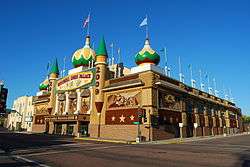
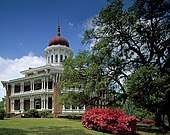
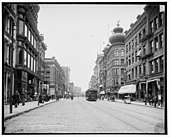 Fuller Block in Springfield (Massachusetts, USA), domes since removed
Fuller Block in Springfield (Massachusetts, USA), domes since removed
See also
Notes and references
- Block, Eric (2010). Garlic and Other Alliums: The Lore and the Science. Royal Society of Chemistry. ISBN 9780854041909.
- Block, Eric (2010). Garlic and Other Alliums: The Lore and the Science. Royal Society of Chemistry. ISBN 9780854041909.
- Shvidkovsky, D. S. (2007). Russian architecture and the West. Yale University Press. ISBN 978-0-300-10912-2.
- Bridge, Nicole (2015). Architecture 101: An Essential Guide to Building Styles and Materials. Avon, MA: Adams Media. p. 88. ISBN 978-1-4405-9007-8.
- A.П.Новицкий. Луковичная форма глав русских церквей. В кн.: Московское археологическое общество. Труды комиссии по сохранению древних памятников. Т. III. Moscow, 1909.
- Б.А.Рыбаков. «Окна в исчезнувший мир (по поводу книги А.В.Арциховского «Древнерусские миниатюры как исторический источник»). В кн.: Доклады и сообщения историч. факультета МГУ. Вып. IV. М., 1946. С. 50.
- Н.Н.Воронин. Архитектурный памятник как исторический источник (заметки к постановке вопроса). В кн.: Советская археология. Вып. XIX. М., 1954. С. 73.
- S. V. Zagraevsky. Forms of the domes of the ancient Russian temples. Published in Russian: Заграевский С.В. Формы глав (купольных покрытий) древнерусских храмов. М.: Алев-В, 2008.
- Г.К.Вагнер. О своеобразии стилеобразования в архитектуре Древней Руси (возвращение к проблеме). В кн.: Архитектурное наследство. Вып. 38. М., 1995. С. 25.
- See, for instance, the most authoritative survey of early Russian architecture: П.А.Раппопорт. Древнерусская архитектура. СПб, 1993.
- Another important consideration proposed by Zagraevsky links the onion-shaped form of Russian domes with the weight of traditional Russian crosses, which are much larger and more elaborate than those used in Byzantium and Kievan Rus. Such ponderous crosses would have fallen aground during a storm, if they had not been fixed to sizeable stones traditionally placed inside the elongated domes of Russian churches. It is impossible to place such a stone inside the flat dome of the Byzantine type.
- Бусева-Давыдова И.Л. Символика архитектуры по древнерусским письменным источникам XI-XVII вв. // Герменевтика древнерусской литературы. XVI - начало XVIII вв. Moscow, 1989.
- "The Byzantine cupola above the church represents the vault of heaven above the earth. On the other hand, the Gothic spire expresses unbridled vertical thrust, which rises huge masses of stone to the sky. In contrast to these, our native onion dome may be likened to a tongue of fire, crowned by a cross and tapering towards a cross. When we look at the Ivan the Great Bell Tower, we seem to see a gigantic candle burning above Moscow. The Kremlin cathedrals and churches, with their multiple domes, look like huge chandeliers. The onion shape results from the idea of prayer as a soul burning towards heaven, which connects the earthly world with the treasures of the afterlife. Every attempt to explain the onion shape of our church domes by utilitarian considerations (for instance, the need to preclude snow from piling on the roof) fails to account for the most essential point, that of aesthetic significance of onion domes for our religion. Indeed, there are numerous other ways to achieve the same utilitarian result, e.g., spires, steeples, cones. Why, of all these shapes, ancient Russian architecture settled upon the onion dome? Because the aesthetic impression produced by the onion dome matched a certain religious attitude. The meaning of this religious and aesthetic feeling is finely expressed by a folk saying - "glowing with fervour" - when they speak about church domes". - See Е.Н.Трубецкой. Три очерка о русской иконе. 1917. Новосибирск, 1991. С. 10.
- Лидов А.М. Иерусалимский кувуклий. О происхождении луковичных глав. // Иконография архитектуры. Moscow, 1990.
External links


.jpeg)

.jpg)
